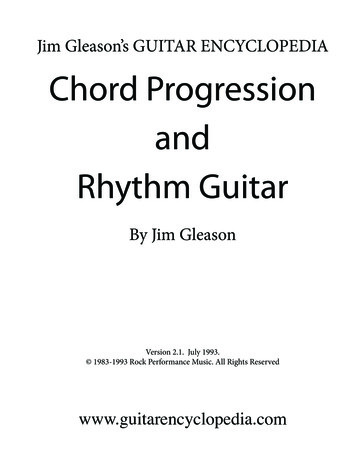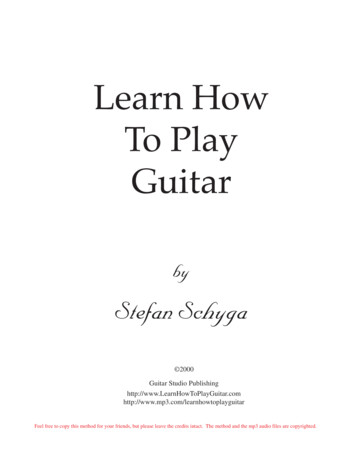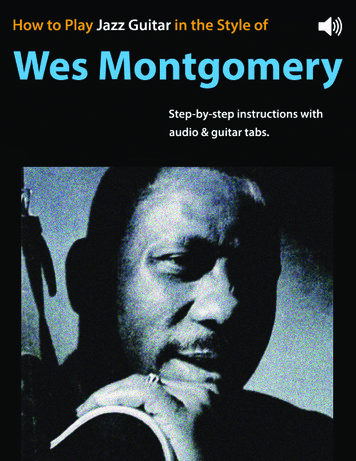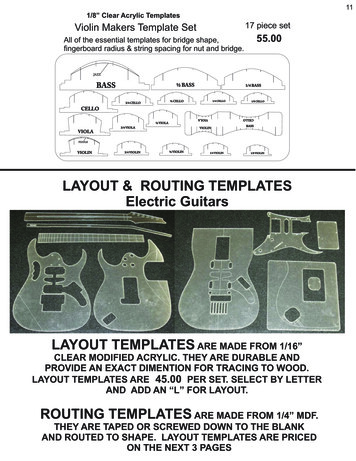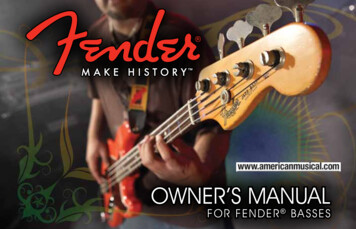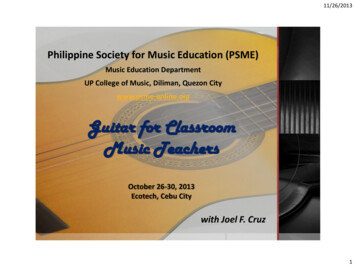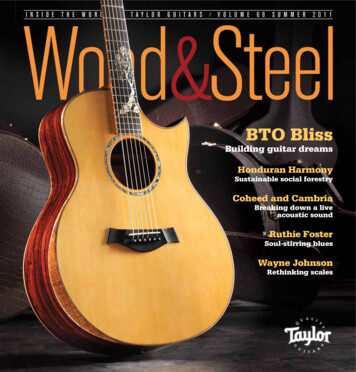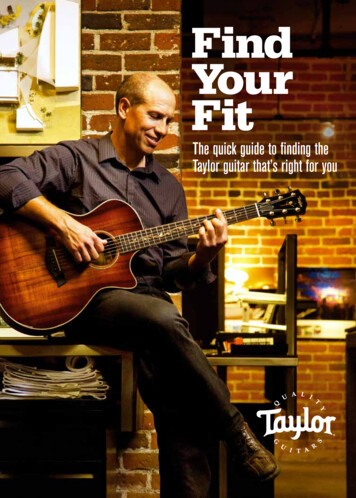
Transcription
FindYourFitThe quick guide to finding theTaylor guitar that’s right for you
finding your fithello!At Taylor Guitars, we’re not just passionate about making greatguitars. We also love helping players find the right guitar fortheir needs. That’s why we’ve created this guide. As you exploredifferent model options in our guitar line, here are a couple ofthoughts to keep in mind.Choosing a guitar is a subjective process.Enjoy it.While our advice is meant to help you in your search, everyone’srelationship with a guitar is unique. The connection we make ispart visual, part tactile, and part sonic, and we each hear andrespond to sound in unique ways. Finding the “right” guitar is acourtship of sorts. You might find your match after weeks of testdriving or in one glorious strum. However it happens, take yourtime, have fun, and trust your feelings. If you do, the right guitarhas a way of finding you.Taylor guitars are more alike than different.Although this guide will help differentiate between models inthe Taylor line — based on the pairing of different body shapesand tonewoods — all Taylor guitars share an underlying familyresemblance when it comes to the fundamental qualities of agreat guitar: they stay in tune, the necks are comfortable to play,and the tone is clear and balanced. Although your search mightboil down to specific details, the bottom line is that with anyTaylor model, you can always count on an enjoyable all-aroundplaying experience.the Taylor difference5 things that set Taylor experience apart123How to choose a Taylor that’s right for youWith a broad range of Taylor options to choose from, an inspiring guitar is within reach of everytype of player. Here are two basic ways to think about finding a guitar that “fits” you:1 Physical Fit: A guitar should be physically comfortable to hold and play.2 Musical Fit: A guitar’s sonic attributes should complement your playing style.Balancing the Tone EquationHere’s a simple “tone equation” we use to help people find the right guitar. It highlights the threemain ingredients that contribute to a guitar’s tonal personality:Manufacturing InnovationTaylor’s world-class factory has reset the standard for modernday precision craftsmanship to create the best possibleplaying experience. Our blend of proprietary productiontechnology with impeccable attention to detail has led tounparalleled consistency in the build quality of our guitars.Playable NecksOur guitar necks are widely considered the most playable inthe industry, thanks to our patented design and sleek,comfortable neck profile. Our neck assembly process allowsus to precisely control every neck angle’s accuracy to .002inch and makes it easy to make micro-adjustments if necessary.No other acoustic guitar company can match our ability toconsistently set a neck for an optimal playing experience.Great ToneOur guitars are known for having clear, balanced voice acrossthe tonal spectrum. Our manufacturing precision has alsoallowed us to push the envelope with tone-enhancing designideas and materials to give players an inspiring array of tonalflavors and a more musically rich playing experience.4Service & Support5Sustainability LeadershipOur commitment to a great customer experience includespersonalized customer service wherever you may be alongyour guitar-playing journey, whether you need help choosing aguitar or taking care of it. From our friendly and knowledgeablestaff to our network of repair technicians, we want to provideyou with a lifetime of great Taylor service.Our commitment to safeguarding the future of the naturalresources we use has led to many pioneering initiatives aroundthe world, from co-ownership and management of Crelicam,an ebony mill in Cameroon, to innovative mahogany-sourcingpartnerships with remote forest communities, to investment inthe propagation of wood species such as maple and koa forfuture generations. We want Taylor customers to feel assuredthat when they purchase a Taylor guitar, they are supportingthe highest levels of ethical, eco-conscious business.Player Body Shape Tonewoods Your Guitar SoundPlayerThe more you understand about your playing style and musical needs,the easier it will be to find a guitar with the pairing of body shape andtonewoods that complement what you do. On the next page, we’ll sharesome questions to help you clearly define your needs as a player.Body ShapeA guitar’s body dimensions literally help shape its fundamental voice.Besides physical comfort, you want a body style that responds well towhat you do. This is often a good place to narrow your search, sinceTaylor offers five main body styles. Once you have a shape in mind, youcan focus on your choice of tonewoods.TonewoodsIf a guitar’s body style produces its fundamental voice, think of thetonewoods used for the top, back and sides as the sonic flavor orseasoning. The distinctive physical properties of each tonewoodspecies (and sometimes even a particular set of wood) help determinethe tonal character, such as the degree of warmth, richness and sustainthe guitar produces.let’s get startedAhead we’ll break down eachcomponent of the tone equation,starting with you.
step 1: player profileThe more you know about your needs and preferences as aplayer the better. If you’re a beginner and don’t have a definedplaying style, that’s OK. Think about your musical interestsand goals and what you want out of a guitar. Here are somequestions to help you. We’ve added a couple of lines next toeach in case you want to jot down some thoughts.5Are there certain tonal properties you havein mind, such as volume, richness, low-endresponse, warmth, etc.?If so, this will help steer you toward an appropriate shape/tonewoodpairing. Rosewood has a deep low end and high end with a rich overtones.Mahogany yields a focused midrange presence. Our new maple guitars arerich and responsive. A cedar top produces warmth that really shines withfingerstyle playing. If you don’t really know what you want, that’s OK. Justsample some different wood options and pay attention to what connectswith you.1Will you be strumming, flatpicking,fingerpicking? A mix?6If you’ll be playing by yourself, you might want a guitar that providesa broader sonic palette to give yourself a wider range of tonal colorsto explore. If you’ll be playing with others, you might want a guitarwith a smaller sonic footprint in order to be heard more clearly in theinstrument mix.This will help you decide whether you need a versatile performer ora guitar that suits a more specialized function. If you’re a novice anddon’t have a clearly defined playing style, leaning toward versatilitywill give you the most latitude to explore different techniques andmusical genres. But if you already own one or more guitars or havea specific musical application in mind, you can be more focused inyour search.23Where will you be playing the guitar?7Will you be singing with your guitar?8Do you plan to play chords or soloshigher up the neck (toward the body)?If you’re looking for a couch strummer or portable option,you might want something that’s smaller and more physicallycomfortable. If you’ll be playing somewhere that demands a goodamount of natural volume and projection without having to plugin the guitar, you’ll likely benefit from a bigger body. If you plan toplay live gigs, worship services, or open mic nights, you’ll want aguitar with a pickup.Do you have a light, medium or heavyattack, and how dynamic a range do youwant?Will you be playing more often by yourself orwith other players/instruments?If so, you’ll want your guitar’s tonal personality to complement yourvoice. You might consider visiting a music store at a time whenyou feel comfortable singing with the guitar or having access to anisolated room where you can pair your voice with each instrument.If you’re more of an instrumental player, does the guitar offer apleasing tonal palette for you to express yourself?If so, a cutaway model is probably a good option.This will help you choose the right body style to accommodate theamount of energy you’ll be applying to the guitar. If you’re a strongstrummer and play a smaller guitar, you’re more likely to overdrivethe top.4What styles(s) of music do you want to play?A bluegrass picker might want a bigger body like a Dreadnoughtor a Grand Orchestra for maximum volume and projection, whilea country fingerpicker might want something smaller like a GrandConcert or Grand Auditorium. An acoustic rocker who wants tostrum rich open chords might prefer a medium-size guitar like aGrand Symphony or a big Grand Orchestra.9Do you plan to do any live performingor recording?If you want to plug in, you should choose a guitar with an onboardpickup. If you plan to record, think about the instrument mix thatmight be involved. If there will be multiple tracks, you might leantoward a smaller body guitar, since it will tend to take up less sonicspace in the mix. If you plan to play solo acoustic guitar, maybe youwant a bigger, more luxurious voice to explore.next step:choosing a body shape
step 2: body shapeBody ShapesRelative To TheGrand Auditorium(GA)Taylor offers five full-size body shapes that range from small and intimate to bigand powerful. Each body’s unique dimensions help define its fundamental voice.In general, a smaller-size guitar will yield a more controlled voice, often with a bitmore upper-end chime, while a bigger size translates into a louder voice, oftenwith more low-end depth.As you sample different body styles, consider how each guitar’s physicaldimensions feel against your body when you hold it. If you play sitting down, howdoes the guitar feel with your picking arm draped over the lower bout? Considerhow the curves, the waist, and the body depth fit you when you play. Chances are,the more comfortable you feel, the more naturally you’ll play.SMALL BODYGCGrand Concert(Models end in a 2; e.g., 812)MEDIUM BODYGA Grand Auditorium(Models end in a 4; e.g., 814)MEDIUM BODYGSGrand Symphony(Models end in a 6; e.g., 816)MEDIUM BODYDN Dreadnought(Models end in a 0; e.g., 810)LARGE BODYGOGA in BlackGC in RedGrand Orchestra (GO)(Models end in an 8; e.g., 818)Sound Profile: Articulate voice with top-end chimeand controlled overtones Intimate size is lap/couch friendly Short-scale neck reduces string tensionfor a slinkier feel Fits well in a mix with other instrumentsSound Profile Taylor’s most popular and versatilebody shape Balanced blend of warmth, clarityand sustain Well-defined midrange Responds well to many music stylesSound Profile Slightly bigger than the GrandAuditorium with more tonal output Very dynamic: rich, powerful voicethat also responds to a light touch Piano-like bass, meaty midrange,strong treble shimmerSound Profile Taylor’s refined take on a traditionalshape and sound Wider waist causes the body to sithigher in the player’s lap A robust “modern vintage” voice Low-end power, snappy midsSound Profile Taylor’s biggest, deepest body shape Taylor’s richest, most complex voice Incredibly balanced for a big-bodiedacoustic guitar Specially braced to also respond to alight touchGood Fit For: Fingerstyle players and light strummers Players who find small bodies morephysically comfortable People with small hands, hand ailments,and others looking to reduce stress ontheir fretting hand Recording applicationsGood Fit For: Novices and generalists who want amultipurpose guitar Recording and live performance Singer-songwriters and musiciansfronting a band Almost anyone other than aggressivepickers/strummersGood Fit For: Dynamic strummers and pickers People who crave more tonal horse-power than the Grand Auditorium Gigging singer-songwriters lookingfor a deep and rich tonal palette 12-string players (many Taylor 12-stringmodels feature the GS shape)Good Fit For: Traditional flatpickers andstrummers with a strong attack People who crave the traditionallook and feel of a wider-waist guitar Pickers and strummers who want astrong low end and throaty midrange Bluegrass musicGood Fit For: Players who want the richest, mostpowerful acoustic voice Players who like a voluptuous, Jumbo-size guitar Solo performers looking for anexpansive palette of sonic colorsand texturesGA in BlackGS in RedGA in BlackDN in RedGA in BlackGO in Rednext step:choosing tonewoods
step 3: tonewoodsA guitar’s tonewoods supply the core ingredients that help flavor its sound.But other nuanced techniques of a guitar maker (like internal bracing) alsohelp season it. That’s one reason why trying to describe the tonal propertiesof woods can be limiting. Another reason is you the player. Your playing style,the type of pick you use, and the brand and gauge of strings you choose areamong the other factors that influence the sound of a guitar.Try this: Find the Taylor body shape that you like best, and then play differentmodels with that same shape but different woods. Pay attention to whicheverone inspires you the most, whether you can explain why or you just feel it.And if the visual aesthetic of the wood is part of the inspiration, embrace it.THE CLASSICSTHE EXOTICSThese claim a rich heritage in the guitar worldAdmired for striking looks and their musical propertiesTHE MODERN ALTERNATIVESLesser known tonewoods but with familiar tone profilesIndian RosewoodMapleTropical MahoganyHawaiian KoaMacassar EbonyOvangkolSapeleModels: 700, 800, 900 SeriesModels: 600 SeriesModels: 500 SeriesModels: Koa SeriesModels: Presentation SeriesModels: 400 SeriesModels: 300 SeriesTone Profile Sweeping frequency range has madeit one of the most popular tonewoods Deep lows assert a throaty growl,sparkling highs ring out with bell-like,high-fidelity clarity Slightly scooped midrange Full-range acoustic voice withcomplex overtones and extendedsustain Yields the strongest bass responseamong the tonewoods commonlyused for guitarsTone Profile Revered in the bowed instrumentworld for centuries for its linear,transparent response; very reflectiveof the player Traditionally known in the guitar worldfor having a bright, focused tone,quick attack, and fast note decay Revoiced for the 600 Series in 2015to yield greater warmth, complexity,volume, sustain and responsiveness,while retaining maple’s naturally clear,linear qualitiesTone Profile Known for a meaty midrange featuringa strong fundamental focus withoutadding a lot of ringing overtones Responds well to players with astrong attack who like dry, earthy,low-fi sounds; natural compressioncreates a volume ceiling thatsmoothes out loose right handtechnique Clear and direct tonal charactermakes it a great option forplaying with other instrumentsTone Profile Fairly dense tropicalhardwood with a strongmidrange focus similar tomahogany, with a bit ofextra top-end brightnessand chime The more a koa guitar isplayed and has a chanceto open up — especially anall-koa guitar — the more itsmidrange overtones add asense of warmth andsweetness to its voiceTone Profile Dense hardwood producesa clear, focused sound withgood projection and volume Strong bass and lower mids,clear highs, and a scoopedmidrange like rosewood Rich overtones complementslower, softer playing Also responds well toaggressive playing It can sound bright or dark,depending on the techniqueof the player or pick choiceTone Profile An African relative ofrosewood that shares manyof rosewood’s tonal proper ties, including a wide spec trum from lows to highs Slightly fuller midrange thanrosewood and a bright trebleresponse resembling koa Bass response adds apleasing depth to theoverall toneTone Profile Comparable to mahoganybut with a slightly brightersound featuring more top end shimmer Consistent and balancedoutput across the tonalspectrum Responds well to a varietyof playing styles and fitsnicely into an instrument mixIndian RosewoodMapleTropical MahoganyHawaiian KoaMacassar EbonyOvangkolSapele
now, find your Taylorlayered wood optionsAll-wood laminates blend affordability and durabilityModels: 100/200 Series, GS Mini, Baby TaylorCrafting guitars with backs and sides of layered, or laminated,woods allows us to conserve tonewood resources (a veneer logwill produce eight times the yield of a log that’s sawn for solidwood guitar sets) and offer players a resilient, affordable andgreat-sounding instrument.Our construction features three layers of wood: a middle coreof poplar with a veneer on each side. The process allows us tobend an arch into the back of the guitar for added strength, andtogether with the layered approach produces a durable guitarthat travels well. Taylor’s layered wood options include layeredsapele, rosewood and koa. All layered wood Taylor guitars featurea solid-wood soundboard, which means the sound of the guitarwill improve as it ages. We’ve moved away from using the term“laminate” to avoid confusion with the growing number of laminateproducts in the acoustic guitar marketplace made from synthetic,non-wood materials.Once you’ve chosen a shape and tonewood pairing that interestsyou, you’re ready for a test-drive! The chart below offers a goodstarting point for identifying specific Taylor models featuring anall-solid-wood construction within the Taylor line. Wood pairingsare organized by series, with each series featuring a unique pack-I likethis shapeGCGAplugging inTaylor electronics serve up reliable amplified acoustic toneYears ago, our passion for great acoustic tone led us into the realmof pickup design. With more players wanting the option to plug in,quality amplified acoustic tone became an important extension ofa guitar’s voice, so we pushed the envelope to develop our ownonboard pickup system to capture the natural tonal nuances of bothour guitars and players. For working musicians especially, havinga reliable pickup is an essential part of their livelihood, and wewanted to offer something that was worthy of the highest caliberworking pros around.The Expression System 2Our latest pickup design, the patented Expression System 2(ES2), brings a major advancement in piezo pickup technologyby capturing more of a guitar’s dynamic properties, thanks to aninnovative behind-the-saddle design. The ES2 is now a standardfeature on most of our steel-string acoustic/electric models.Whenever you’re ready to plug in, you can count on your Taylorpickup to help you sound your best.GSDNGOage of appointments such as inlays, binding, and other aestheticdetails. Models that have a cutaway will include a “c” in the name,and those that come with acoustic electronics will have an “e”on the end (e.g., 814ce). You’ll find a comprehensive list of Taylormodels at taylorguitars.com.This woodworks for meFound inthis seriesYou’ve founda model to try!MacassarPresentation SeriesPS12KoaKoa SeriesK22Rosewood900, 800 & 700 Series912, 812, 712Maple600 Series612Mahogany500 Series522, 512Ovangkol400 Series412Sapele300 Series322, 312MacassarPresentation SeriesPS14KoaKoa SeriesK24Rosewood900, 800 & 700 Series914, 814, 714Maple600 Series614Mahogany500 Series524, 514Ovangkol400 Series414Sapele300 Series324, 314MacassarPresentation SeriesPS16KoaKoa SeriesK26Rosewood900, 800 & 700 Series916, 816, 716Maple600 Series616Mahogany500 Series526, 516Ovangkol400 Series416Sapele300 Series326, 316MacassarPresentation SeriesPS10KoaKoa SeriesK20Rosewood900, 800 & 700 Series910, 810, 710Maple600 Series610Mahogany500 Series520, 510Ovangkol400 Series410Sapele300 Series320, 310MacassarPresentation SeriesPS18KoaKoa SeriesK28Rosewood900, 800 & 700 Series918, 818Maple600 Series618Mahogany500 SeriesN/AOvangkol400 Series418Sapele300 SeriesN/A
about TaylorTaylor Guitars was founded in 1974 in Lemon Grove, California, by BobTaylor and Kurt Listug. Thanks to Taylor’s pioneering use of modern toolsand technology to refine the guitar-making process, the company has setnew quality standards for playability and tone and established Taylor as theindustry’s leading acoustic guitar manufacturer. We’re headquartered in ElCajon, California (in San Diego’s East County). We offer a guided factorytour weekdays at 1 p.m. and invite you to come experience our operationfirsthand. For directions and other details, visit taylorguitars.com.1980 Gillespie Way El Cajon, CA 92020 (619) 258-1207 taylorguitars.com 2015 Taylor Guitars
A guitar should be physically comfortable to hold and play. Musical Fit: A guitar’s sonic attributes should complement your playing style. let’s get started Player Body Shape Tonewoods Your Guitar Sound Player The more you understand about your playing style and musical needs, the easier it will be
